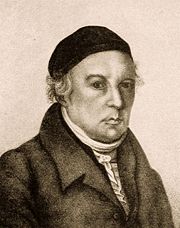
Johann Anton André
Encyclopedia

Germany
Germany , officially the Federal Republic of Germany , is a federal parliamentary republic in Europe. The country consists of 16 states while the capital and largest city is Berlin. Germany covers an area of 357,021 km2 and has a largely temperate seasonal climate...
composer
Composer
A composer is a person who creates music, either by musical notation or oral tradition, for interpretation and performance, or through direct manipulation of sonic material through electronic media...
and music publisher.
André wrote opera
Opera
Opera is an art form in which singers and musicians perform a dramatic work combining text and musical score, usually in a theatrical setting. Opera incorporates many of the elements of spoken theatre, such as acting, scenery, and costumes and sometimes includes dance...
s, symphonies
Symphony
A symphony is an extended musical composition in Western classical music, scored almost always for orchestra. A symphony usually contains at least one movement or episode composed according to the sonata principle...
, masses
Mass (music)
The Mass, a form of sacred musical composition, is a choral composition that sets the invariable portions of the Eucharistic liturgy to music...
, and lied
Lied
is a German word literally meaning "song", usually used to describe romantic songs setting German poems of reasonably high literary aspirations, especially during the nineteenth century, beginning with Carl Loewe, Heinrich Marschner, and Franz Schubert and culminating with Hugo Wolf...
er, as well as a still unfinished Lehrbuch der Tonsetzkunst (Textbook of the Art of Composition
Musical composition
Musical composition can refer to an original piece of music, the structure of a musical piece, or the process of creating a new piece of music. People who practice composition are called composers.- Musical compositions :...
) in two volumes. In 1799, André purchased a large volume of Mozart
Wolfgang Amadeus Mozart
Wolfgang Amadeus Mozart , baptismal name Johannes Chrysostomus Wolfgangus Theophilus Mozart , was a prolific and influential composer of the Classical era. He composed over 600 works, many acknowledged as pinnacles of symphonic, concertante, chamber, piano, operatic, and choral music...
's musical papers (the Mozart-Nachlass) from his widow Constanze
Constanze Mozart
Constanze Mozart was the wife of Wolfgang Amadeus Mozart.-Early years:Constanze Weber was born in Zell im Wiesental. Her mother was Cäcilia Weber, née Stamm. Her father Fridolin Weber worked as a "double bass player, prompter and music copyist." Fridolin's half-brother was the father of composer...
, and brought them to Offenbach. This collection contained over 270 autograph
Autograph
An autograph is a document transcribed entirely in the handwriting of its author, as opposed to a typeset document or one written by an amanuensis or a copyist; the meaning overlaps with that of the word holograph.Autograph also refers to a person's artistic signature...
s and included the operas The Marriage of Figaro
The Marriage of Figaro
Le nozze di Figaro, ossia la folle giornata , K. 492, is an opera buffa composed in 1786 in four acts by Wolfgang Amadeus Mozart, with Italian libretto by Lorenzo Da Ponte, based on a stage comedy by Pierre Beaumarchais, La folle journée, ou le Mariage de Figaro .Although the play by...
and The Magic Flute
The Magic Flute
The Magic Flute is an opera in two acts composed in 1791 by Wolfgang Amadeus Mozart to a German libretto by Emanuel Schikaneder. The work is in the form of a Singspiel, a popular form that included both singing and spoken dialogue....
, a series of string quartets and string quintets, several piano concertos
Mozart piano concertos
The Mozart piano concertos refer to the 27 concertos for piano and orchestra written by Wolfgang Amadeus Mozart. These works, many of which Mozart composed for himself to play in the Vienna concert series of 1784–86, held a special place for him; indeed, Mozart's father apparently interrupted him...
, and Eine kleine Nachtmusik
Eine kleine Nachtmusik
The Serenade No. 13 for strings in G major, K. 525 was written by Wolfgang Amadeus Mozart in 1787. The work is more commonly known by the title Eine kleine Nachtmusik. The German title means "a little serenade", though it is often rendered more literally but less accurately as "a little night music"...
. Based on these autographs, the André publishing house (founded in 1774 by André's father Johann André
Johann André
Johann André was a German musician, composer and music publisher.In 1774, as the patriarch of a Huguenot family, André founded one of the first music publishing houses to be independent of a bookshop, in Offenbach am Main...
(1741–99) and still owned by the family today) prepared and issued some highly respected editions of Mozart's works, bringing many compositions into print for the first time. For his central contributions, André earned the title "father of Mozart research".
The success of the firm turned crucially upon a meeting in Munich in 1799 between André and Alois Senefelder
Alois Senefelder
Johann Alois Senefelder was a German actor and playwright who invented the printing technique of lithography in 1796.-Actor, playwright:...
, the inventor of lithography
Lithography
Lithography is a method for printing using a stone or a metal plate with a completely smooth surface...
. Senefelder agreed to collaborate with André and granted his firm the right of using the new printing method for the first time, which took place in 1800 when the vocal score of André's own opera Die Weiber von Weinsberg came off the press. In 1839, André handed over the business to his son Johann August André (1817–87).

